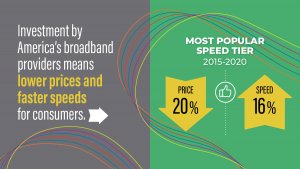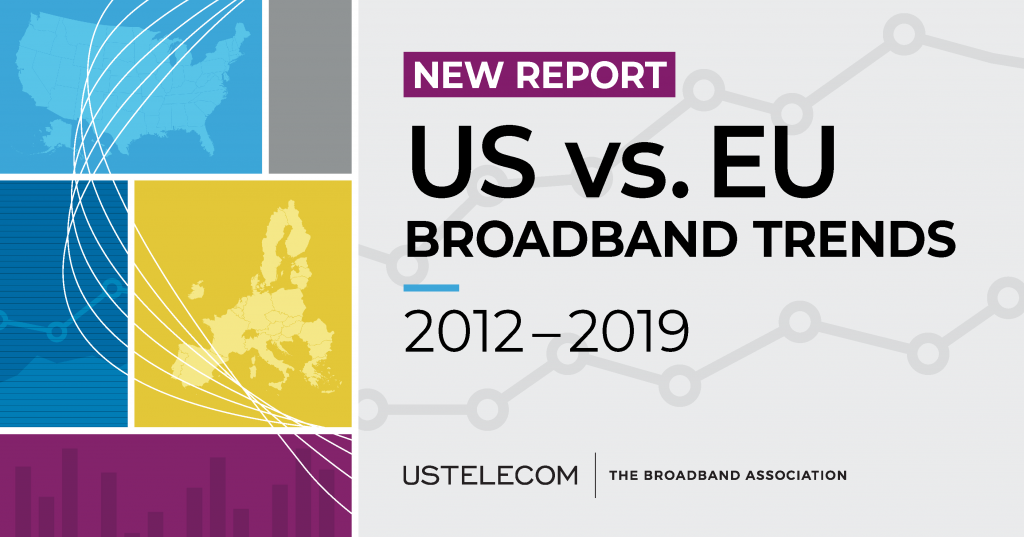April 21, 2021
Broadband companies invest more than three times as much in telecommunications infrastructure per household in U.S. than EU—about $700 per home annually
U.S. deployment advantage: leads EU by 12 percentage points at 30 Mbps; 25 point lead for ≥100 Mbps
U.S. broadband infrastructure advantage most significant in rural areas
Pro-investment approach in U.S. produced twice the facilities-based competition for U.S. consumers compared to EU
WASHINGTON, DC – USTelecom | The Broadband Association, a leading association of connectivity providers and technology innovators, today released new research showing the United States leads the European Union (EU) in broadband deployment and adoption, while outpacing Europe on key investment and competition measurements as well.
The study: US vs. EU Broadband Trends (2012-2019) debunks a persistent myth that the EU’s more intensive framework for broadband regulation has yielded a superior online experience for consumers and ought to be replicated in the United States.
The USTelecom report points to the exact opposite conclusion. The data indicates the U.S. approach – specifically, a collaborative public-private policy framework that incentivizes capital-intensive private investment over government regulation – has not only delivered a more competitive U.S. broadband marketplace than Europe, it has also fueled additional benefits, including declining U.S. broadband prices, superior network resilience, and the ability for consumers to more fully utilize digital tools and resources.
USTelecom President and CEO Jonathan Spalter said: “As Washington dives into the broadband infrastructure debate, this new report should be instructive to policymakers about what works – and what doesn’t work – when it comes to bridging the digital divide and delivering 21st century connectivity to more Americans. To those who think more regulations and more government thumb on the scale intervention is the right approach, I say just look to Europe, which chronically lags the United States in broadband deployment, adoption, investment and competition.”
US vs. EU Broadband Trends (2012-2019) key findings:
- The U.S. handily leads EU in both broadband infrastructure deployment and broadband adoption—at all speeds;
- Significant deployment advantage: U.S. leads EU by 12 percentage points at 30 Mbps; 25 point lead for ≥100 Mbps;
- Significant adoption advantage: U.S. leads EU by 9 percentage points at 30 Mbps; 21 point lead for ≥100 Mbps;
- U.S. infrastructure advantage is most significant in rural areas where it leads EU by more than 20 points at 30 Mbps;
- Broadband providers invest substantially more in U.S. versus EU infrastructure (more than three times per household – about $700 per home each year);
- U.S. consumers enjoy twice the facilities-based competition as their EU counterparts.
Spalter added: “It’s no contest. If the U.S. had followed the EU’s more regulatory broadband path, our digital divide would be substantially bigger and our shared networks considerably less prepared for the traffic demands of the pandemic and our increasingly connected economy.”
US vs. EU Broadband Trends (2012-2019)
This research reinforces the findings of USTelecom’s 2020 Broadband Pricing Index (BPI) showing the decreasing cost and increasing value of broadband service in the United States, including:
 The most popular tier of broadband service in 2015 is now priced about 20 percent lower and offers nearly 16 percent faster speeds in 2020.
The most popular tier of broadband service in 2015 is now priced about 20 percent lower and offers nearly 16 percent faster speeds in 2020.- These price reductions run counter to inflation, which increased consumer costs for overall goods and services by 9.3 percent over the same five-year period.
ABOUT USTELECOM
USTelecom is the national trade association representing technology providers, innovators, suppliers, and manufacturers committed to connecting the world through the power of broadband.
